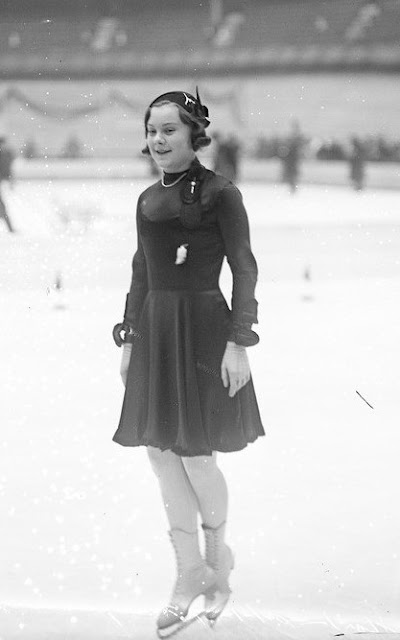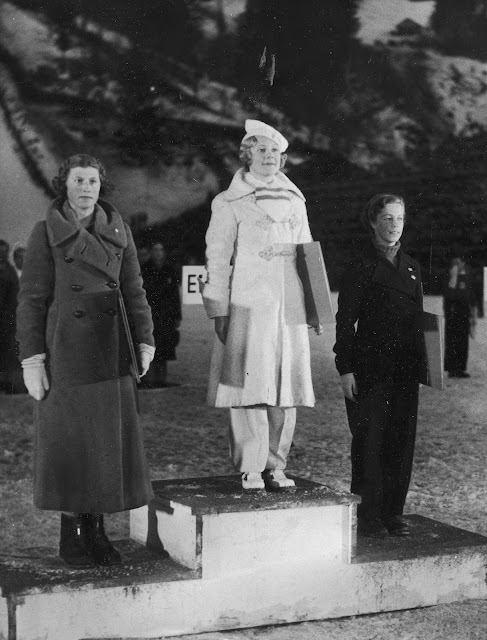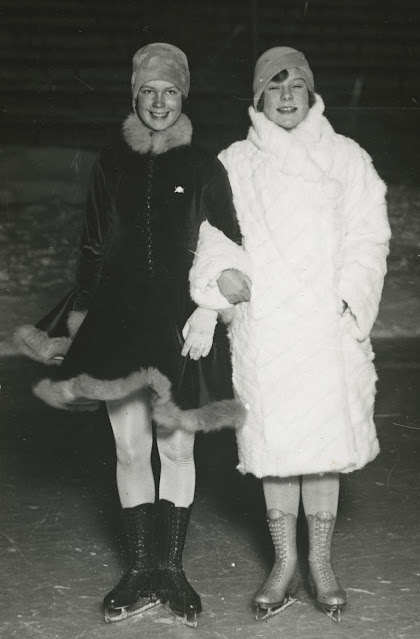Sonja Henie. Photo courtesy Bibliothèque nationale de France.
Sonja Henie dazzled the world with her Hollywood smile and sensational skating, winning three Olympic gold medals and ten gold medals at the World Figure Skating Championships.
In Sonja Henie's day, a cadre of equally gifted women fought a very different battle on the ice: one for recognition.
History remembers Henie as the unstoppable queen of figure skating, but behind every one of her titles stood a line of ambitious, resilient, and often overlooked competitors. Sonja Henie lived rent-free in many of their minds.
Herma Szabo. Photo courtesy Bibliothèque nationale de France.
In 1926, Sonja Henie faced off against the reigning Olympic gold medalist and World Champion Herma Szabo at the World Championships in Stockholm, Sweden. Reflecting on that event in the documentary ISU: 100 Years of Skating 1892–1992, Szabo recalled, "Sonja Henie made my life very difficult and her father even more. In Stockholm at the Worlds, we were invited to the Austrian Consulate in the evening and I left my skates in the lounge. The next day was the competition and on my first step on to the ice, the sole with the skates came off my shoe. It had been cut off with a razor blade. That was not nice."
Decades later, in 1994, Fritzi Burger-Russell claimed that Szabo had confided in her about a suspicious encounter. According to Burger-Russell, Szabo said that she "thought she saw a member of the Norwegian delegation in the corridor as she returned to her hotel room the night before the competition – but nothing was ever proved."
Herma Szabo defeated Sonja Henie at the 1926 World Championships, but the following year, the tables turned. At the 1927 World Championships in Oslo - Henie’s home turf - she claimed the title, with three of the five judges hailing from Norway. All three Norwegian judges voted for Henie, while the remaining two, an Austrian and a German, scored Szabo higher. The controversial result sparked a public outcry and ultimately led to a new rule limiting international judging panels to one judge per country.
Disheartened by the outcome, Szabo retired from the sport shortly afterward. In the charming 1998 documentary Reflections On Ice: A Diary Of Ladies Figure Skating, Fritzi Burger-Russell recalled, "Herma came to my house in Vienna and brought me some tights and a skirt and said, 'now try to beat her!' Didn't help any."
In an interview with Maribel Vinson Owen, following the 1936 Winter Olympics, Sonja Henie expressed utter frustration over the whole scandal. She remarked, "It made me so mad to have people say my winning was unfair... I immediately offered to skate the competition over two weeks later on the indoor ice rink in London - after all, what could I do more than that? - but [Herma Szabo] would not do it and just retired instead."
Fritzi Burger-Russell passed away on February 17, 1999, while vacationing in Austria. After winning the 1930 European title and silver medals at the Winter Olympics and World Championships, her engagement to a German bobsledder was called off because she was Jewish... in a very dangerous time and part of the world. She married Shinkiki Nishikawa, the grandson of Japanese Pearl Tycoon Kokichi Mikimoto in Vienna in 1935 and had a son named Yoshikazu. After spending World War II in Japan, she remarried banker Bob Russell in 1968 and moved to the United States. In the decades after she retired from skating, Sonja Henie was always on Fritzi Burger-Russell's mind. Quoted in a 1994 interview in "The New York Times", she said, "In Budapest, at the 1929 World Championships, I thought I should have won. Sonja didn't skate well; she nearly fell doing a sit spin. But her father began clapping his walking stick so that people would start clapping for her."
Cecilia Colledge performing a layback spin. Photo courtesy "Skating" magazine.
Maribel Vinson Owen recalled a dramatic incident that occurred during the women's school figures at the 1936 Winter Olympic Games, held in Nazi Germany. During the right back bracket change bracket, Vinson Owen remembered, "[Sonja] had almost no speed for the second half of the figure, she came up to the second bracket right on the flat of her skate instead of on an edge, a major fault, and after the turn she had to wiggle and hitch her skating foot to keep going, and then she pushed off for the next circle a good four feet before she reached her center, another very major fault... and when she had turned her twelfth and last bracket, she was at a dead standstill. So, making no pretense of trying to finish out her circle, she just put both feet down, smiled a gay camouflage smile, and walked off the ice. We gasped to see the world champion do such a thing. The figure as it stood, deserved no more than Vivi[-Anne Hultén]'s 3.8 average, if as high as that, and yet when the judges put down their cards, not one, not even Mr. [Charlie] Rotch, who indeed does know correct figures, had given her less than 5! We competitors and those on the sidelines who knew laughed in derision with a 'what can you expect' tone - I looked at Mr. Rotch with the question 'How could you do such a thing?' in my eyes, and he just shrugged." Despite this display, Sonja defeated Cecilia Colledge by 3.6 points... a margin too close for her comfort. Steven J. Overman and Kelly Boyer Sagert's book "Icons Of Women's Sport, Volume 1" claimed, "This unnerved Henie, who had beaten Colledge in the previous World Championships on the strength of her compulsory figures; upset because of the closeness of the competition, Henie yanked down Colledge's score from the board and tore it to pieces." Fritzi Burger-Russell claimed that Sonja Henie lashed out at her in the elevator at the hotel, accusing her of spreading "advertisements" about Cecilia Colledge's superiority in the school figures. "We almost got into a fight. Well, not really. It was just a little argument. I told her I could say whatever I liked," Burger-Russell later recalled.
Cecilia Colledge, Sonja Henie and Vivi-Anne Hultén on the podium at the 1936 Winter Olympic Games. Photo courtesy National Archives of Poland.
British skating stars Cecilia Colledge and Megan Taylor had no love lost for Sonja Henie either. Phil Taylor wagered a thousand-dollar bet that his daughter and pupil Megan could defeat Sonja in any fair "challenge test". Cecilia Colledge recalled how Henie would isolate herself from her competitors. "She never talked to us," Colledge remarked. "To her, there were no other skaters. Even on the podium after the Olympics, there were no kisses, no handshakes, not even a word. She never would have considered saying something nice."
Lucienne Bonne at the Palais de Glace in Paris in 1932. Photo courtesy Bibliothèque nationale de France.
Then there was the alleged run-in between Sonja and French skater Lucienne Bonne. Canadian journalist Dick Beddoes recalled, "One likes to think of the night in Paris in 1932, in Jeff Dickson's Palais des Sports, when Sonja Henie, the Olympic Champion from Norway, was skating 'The Dying Swan', to the music of Saint-Saëns. Suddenly, from the balcony, came a serenade on tin whistles. Henie burst into tears - though not until after counting the house - and management announced that the tin whistle claque had been paid for by a rival skater, Lucienne Bonne. Mlle. Bonne denied everything. 'But what of it?' she added. 'This Norwegian nuisance stole my Swan!'"
Cecil Smith. Photo courtesy City of Toronto Archives.
Canada's Cecil Smith, who finished second to Sonja Henie at the 1930 World Championships, claimed that Sonja stole her idea of wearing white boots. In David Young's 1984 book "The Golden Age Of Canadian Figure Skating", Smith recalled, "First came Sonja, swathed in furs. Then came Mother, swathed in furs. Then Papa Henie, with a fur coat and cigar. Then the brother, with long blond hair, carrying Sonja's skates, and behind him, one of the international judges. Sonja walked over to my patch to see what my figures were like, but I said nothing - just smiled... At that time, only professionals wore white skating boots, while the rest of us wore black or tan. I decided I was going to wear white boots in the World Championships. Well, my mother was horrified. She thought it was brash, and the effect on the judges would be too startling, but I did it anyway. Three months later, Sonja was wearing white boots too." Henie later told the press that she wore white boots because they "reminded her of the beautiful snow in Norway".
Photo courtesy "Skating" magazine
Who could forget Olympic Bronze Medallist Vivi-Anne Hultén, whose candid remarks about Sonja Henie around the time of the 1994 Winter Olympic Games in Lillehammer ruffled some feathers. In an interview with "Sports Illustrated" magazine in the 1990s, Hultén recalled, "Look, I have a great admiration for what Henie did... On the ice, she was terrific, a wonderful acrobat, just like a circus princess, a big smile, dressed perfectly. But she was Dr. Jekyll and Mr. Hyde, a very nasty person off the ice.... I'm just telling it like it is."
A 2003 article from "The Los Angeles Times" relayed several tales of the rivalry between the two famous 1930s skaters with the last name H: "The rift began at the 1933 World Championships, when Hultén finished only two-tenths of a point behind Henie. 'You are not nearly good enough to get second next to me,' Henie screamed afterward, pointing a finger at Hulténs nose. 'I'm so much better than you are. You deserved to be fourth.'" At the 1934 World Championships], that's exactly where Hultén finished.
Vivi-Anne Hultén and Sonja Henie. Photo courtesy Sveriges Centralförening för Idrottens Främjande.
"'Her father arranged it. She was afraid of me," Vivi-Anne Hultén told a reporter from the "Minneapolis Star Tribune". Hultén claimed that Sonja Henie's father made deals with judges at world championships to ensure his daughter's victories. "Papa Henie would go to these places and tell the organizers, 'You can have my daughter (for an exhibition); come up to my hotel room and I'll tell you how we can arrange it. He played poker with them. If he won, he got an appearance fee for Sonja to skate and he got an agreement that the judges would place me no higher than third. I didn't have a chance. I know this is true because one of my best friends was the President of our club in Stockholm, and he told me about it. Back then, the judges were always with the clubs,'" Hultén claimed.
On a trip to St. Moritz in late 1935 to train for the 1936 Winter Olympic Games, Hultén was detained at the German border for seven hours and searched from head to toe by a guard named Ulrich Schmidt. After she was released, Hultén filed a complaint with Joseph Goebbels, the Reich Minister of Propaganda. Goebbels summoned Schmidt and made him get down on one knee and apologize to Hultén. Schmidt admitted to Goebbels, "A young lady came through before her whose name was Sonja Henie. She told me this girl here would be smuggling jewelry, so we stopped her.'"
Belita Jepson-Turner
In the heyday of Sonja Henie's success as a professional, she was a Hollywood star with her name in lights and a lucrative contract with Twentieth Century-Fox. Belita Jepson-Turner, a multi-talented skater/actress/dancer from the UK, had a contract with Monogram Pictures at the same time. When interviewed by David Jacobs in the 1970s and asked directly about her relationship with Sonja Henie, Belita responded with a coy, knowing smile and a carefully measured reply: “That’s a difficult question. I don’t know that I was a successor. We were quite different in style! She was signed up to Twentieth Century-Fox. They actually offered me a contract for life, for as much money as I wanted, if I never touched skates again." When pressed about whether the two were rivals, she added coolly, "Uh, that’s her opinion, not mine."
Sonja Henie and Hilde Holovsky
Despite their rivalry, Fritzi Burger-Russell, Cecilia Colledge and Maribel Vinson Owen, among others, were able to find charitable things to say about Henie at times. They recognized her undeniable talent and the role that the powerful machine behind her success, her determined Papa, played in the behind-the-scenes wheeling and dealing of those days.
While skating lore will likely always be laced with larger-than-life tales of Sonja Henie and her ever-watchful father, it's hard to dismiss the chorus of voices from those who shared the ice with her. Surely not every grievance was sour grapes, and not every victory squeaky clean. But what’s equally true is this: love her or loathe her, Sonja Henie reshaped figure skating forever. Without the rivals who pushed her — and sometimes pushed back — the story wouldn’t be nearly as compelling.
Skate Guard is a blog dedicated to preserving the rich, colourful and fascinating history of figure skating. Over ten years, the blog has featured over a thousand free articles covering all aspects of the sport's history, as well as four compelling in-depth features. To read the latest articles, follow the blog on Facebook, Bluesky, Pinterest and YouTube. If you enjoy Skate Guard, please show your support for this archive by ordering one of eight fascinating books highlighting the history of figure skating: https://skateguard1.blogspot.com/p/buy-book.html.











